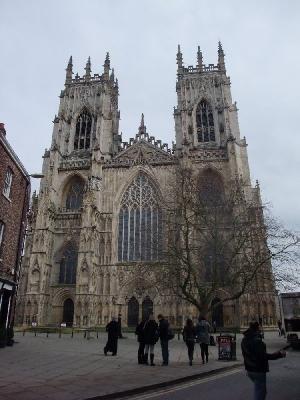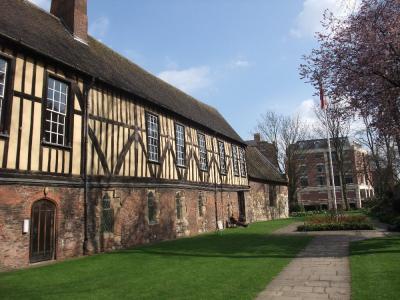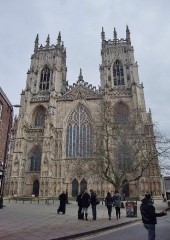Doctor Kate Giles is a Senior Lecturer in Buildings Archaeology at the University of York. As Undergraduate Admissions Tutor she is also the first point of contact for any student joining the archaeology department.
Post Hole Co-Editor Mark Simpson, who has a keen interesting in Buildings Archaeology, conducted this e-mail interview in April 2012.
Mark Simpson - Your initial interest was in history and art history. What drew you to these subjects?
Kate Giles - It was always buildings! I have always loved historic buildings and wanted to learn how to research and study them. I initially registered for a History degree, then had a taste of art history in my first year and so changed to a Joint Honours programme so I could take modules in Gothic buildings with Professors Christopher Norton and Richard Marks. Mind you, whilst my colleagues were sunning themselves on art history field trips to Florence, Paris and New York, I was driving round North Yorkshire in a minibus!
MS - You then moved on to buildings archaeology, which some would see as quite a change of direction. Why the change?
KG - I did not realise that archaeologists studied buildings until I came across the work of Jane Grenville and the Archaeology of Buildings programme here in the department. As soon as I started the course I realised that this was the way in which I wanted to study buildings, combining systematic survey with the historical research and interpretation.
MS - Having been the York Minster Archaeology Research Fellow for twelve years now, what do you find so fascinating about the building?
KG - Oh dear, yes it is that long! Well, I suppose it is that every time we do work in the Minster we discover something amazing and different, such as the recent discovery of burials in the South Transept. I also really like working with an institution where research feeds back into education, such as the training of the stonemasons, and to the general public.
MS - Can you tell us about your time at the Borthwick Institute for Archives? What is so interesting about old documents?
KG - Documents for me are a form of material culture. Like an artefact or building, they had a specific purpose, and were written with certain interests in mind - but not those of the archaeologist, usually! However, it is the challenge of taking a series of documents and working through them to really build up a rich and detailed picture of a building or a place which I love. It is one of the ways in which you really feel you are immersing yourself in the voices of the past, even if they sometimes had really illegible handwriting!
MS - Your specialist research area is in medieval guildhalls. Why guildhalls?
KG - It is very unusual in Archaeology to be one of the first people to really think about and understand a type of site or monument. That is what initially attracted me to Guildhalls — the absence of previous study of them. However, I soon realised that they had a fascinating story to tell about the heyday of medieval religious culture as well as the impact of the Reformation on medieval society. More recently I also have become really interested in the Antiquarians who studied these buildings in the 19th and 20th century. I really enjoy building up the layers of a story to explore what this tells us about the use and meanings of buildings over time.
MS - What is your favourite of all the buildings you have researched, and why?
KG - Well, the Merchant Adventurers Hall in York will always be one of my favourites, but the Stratford-upon-Avon Guildhall and Guild Chapel is my current passion. This is partly because of the quality of the building, its archaeology and history, which is so rich. However, it has also been the opportunity to work collaboratively with my colleagues, Dr Jonathan Clark of Field Archaeology Specialists, Dr Anthony Masinton from the Department and PhD student Ollie Jones, as well as our Stratford friends, which has made the project so exciting. Performing in the hall last July was a real highlight, and has now led to conversations with colleagues from Canada on developing an international research project 'theatre archaeology'.
MS - Recently you worked on an archaeology project with your sister (Dr. Melanie Giles, University of Manchester). What was this like? Do people often get the two of you mixed up?
KG - It has been brilliant. The farm graffiti project has been a great way of combining our interests in the Wolds with historic buildings research. In the past people were occasionally confused by us, but I think most people can now tell us apart. I did once get a nasty phone call from the Inland Revenue wondering why I was moonlighting at another University - they took some convincing that there were two of us out there!
MS - You sit on a number of committees, get invited to give talks around the world, publish, teach undergraduates and postgraduates and hold a variety of departmental roles. Do you manage to relax away from archaeology at all?
KG - Yes! I live in a village in North Yorkshire and am very involved in village life. Mind you, that does tend to involve a lot of archaeology, fundraising for the Church Tower Restoration and most recently organising a Local History weekend.
MS - The University of York has no female professors of archaeology. Do you have any ambitions to reverse this inequality?
KG - Well, I have only just become a Senior Lecturer, so I have some way to go, I think! What matters most to me is the opportunity to carry on researching the buildings that I love, and putting that passion into my teaching, supporting the next generation of academics and professionals. I feel very lucky to be part of a Department where this is really valued and encouraged.
MS - And finally, you are known to have a passing interest in cocoa-based products. Do you have a favourite among these?
KG - Betty's Hot Chocolate, best consumed in Little Betty's, Stonegate!






